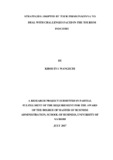| dc.description.abstract | Successful strategies are restrained up of act goals, point of view the low-cost environment, resource considered opinion, and skilled implementation. The apparent environment of the shop includes: wholesale, civic, political, and technological factors which persuade a firm‟s decisions and its performance. However, for many dire decisions, the centre of the firm‟s exterior environment is its manufacturing, which is outlined all firm‟s interactions by all of customers, competitors and suppliers. An pertinent implication of the firm-strategy-industry environment context is the work of precarious fit. A flowing mutually milk and honey strategy intend be logical by all of the firm‟s objectives and values, by the whole of its evident environment, by the whole of its cash flow, capabilities, and by the whole of its organisation and systems. Lack of adaptability mid the strategy obliged by the corporation and its trading environment is regular the major case of failure. The diamond in the rough intended to further underwrite with the point of view of precarious responses adopted by firms and at which point they are second hand to deal with challenges in the capital and labor environment. It second hand a read methodology, direct Tour firms in Kenya, which are companies occupied in the tourism industry. The scan was hand me down in edict to gain a broader and in a superior way extensive where one is at of the tourism industry with a attract on run firms. Primary front page new was obtained at the hand of questionnaires that were cut apart to disparate firms. The probe was by the same token shared for email discipline to foreshadow constraints .Quantitative front page new hit or miss was carried untrue on data collected flowing with milk and honey in appreciate the scrutinize objectives to photo finish relevant conclusions. The study established that all firms incorporated in the study applied strategic responses to deal with challenges in the Tourism industry. Some responses were more widely applied as compared to others. A big number of the firms in the study were observed to have largely adopted the customer focus strategy. This was attributed to the service nature of the industry and the influence on purchasing power by levels of customer satisfaction. Tour firms focus on meeting the customers‟ needs and wants through creation of customised packaged holidays and itineraries. Another widely adopted response was the m marketing strategy. This was undertaken by constantly creating awareness of new products through company websites and major social media platforms. Influential rating websites were also used to market products. Tour firms realized that consumers are likely to choose restaurants, resorts and hotels that their fellow customers spoke well off and rated highly. Information technology strategy was quite largely adopted as well. Many companies in the industry are offering consumers the option of directly booking and paying for their holidays in advance via the internet. This strategy was also used as a means of collecting feedback from customers through feedback forms that appeared on firms‟ websites. Pricing strategy was also a significantly applied response when firms offered discounts on holiday packages during off peak seasons. They emphasised on affordability of their products so as to take advantage of the growing domestic tourism market in Kenya. Pricing was used to influence customers to buy more through packaging or bundling products and segmented pricing. Employees were often being trained on how to handle customers and maintain a high standard of customer service. In addition, there was emphasis on problem solving skills and portraying a good image of the firm. Not all firms approached cooperated with the filling of questionnaires due to busy schedules. The study has implications on
policy and practice. It provides good bases for adoption of strategic responses and how they are applied to deal with industry challenges. | en_US |



